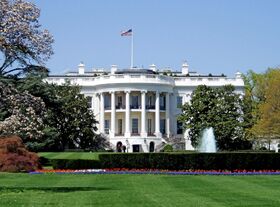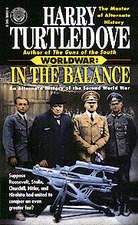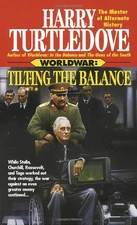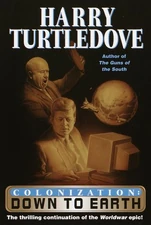ML4E (Message Wall | contribs) |
No edit summary Tag: rte-source |
||
| Line 3: | Line 3: | ||
The '''White House''' is the official residence and principal workplace of the [[President of the United States]], located at 1600 Pennsylvania Avenue NW in [[Washington, D.C.]] It has been the residence of every U.S. president since [[John Adams]] in 1800. |
The '''White House''' is the official residence and principal workplace of the [[President of the United States]], located at 1600 Pennsylvania Avenue NW in [[Washington, D.C.]] It has been the residence of every U.S. president since [[John Adams]] in 1800. |
||
| − | The house was designed by Irish-born James Hoban, |
+ | The house was designed by Irish-born James Hoban, and built between 1792 and 1800 of white-painted Aquia Creek sandstone in the Neoclassical style. |
<p class="western" style="margin-bottom: 0cm">In 1814, during the [[War of 1812]], the mansion was set ablaze by the [[British Army]] in the Burning of Washington, destroying the interior and charring much of the exterior. When reconstruction of the building began, the burnt walls were painted over in white, giving rise to the name ''“The White House.”''</p> |
<p class="western" style="margin-bottom: 0cm">In 1814, during the [[War of 1812]], the mansion was set ablaze by the [[British Army]] in the Burning of Washington, destroying the interior and charring much of the exterior. When reconstruction of the building began, the burnt walls were painted over in white, giving rise to the name ''“The White House.”''</p> |
||
| Line 14: | Line 14: | ||
== White House in [[Southern Victory]]== |
== White House in [[Southern Victory]]== |
||
| − | <p class="western" style="margin-bottom: 0cm">The '''White House''' was the residence of the [[President of the United States (Southern Victory)|US Presidents]] within [[Washington, DC (Southern Victory)|Washington DC]] from 1800 until 1881. |
+ | <p class="western" style="margin-bottom: 0cm">The '''White House''' was the residence of the [[President of the United States (Southern Victory)|US Presidents]] within [[Washington, DC (Southern Victory)|Washington DC]] from 1800 until 1881. This included the period of the [[War of Secession]] from 1861 to 1862. In November of 1862, the peace was negotiated within the White House, officially bringing the war to an end.</p> |
| − | In the years that followed, the White House still housed the Presidents of the [[United States (Southern Victory)|United States]] until 1881. When the [[Second Mexican War]] began, the commander of all US forces, Major General [[William Rosecrans#William Rosecrans in Southern Victory|William Rosecrans]] refused to surrender the city, which resulted in Washington being attacked by Confederate artillery, damaging the White House. President [[James G. Blaine (Southern Victory)|James G. Blaine]] evacuated the seat of government to [[Philadelphia |
+ | In the years that followed, the White House still housed the Presidents of the [[United States (Southern Victory)|United States]] until 1881. When the [[Second Mexican War]] began, the commander of all US forces, Major General [[William Rosecrans#William Rosecrans in Southern Victory|William Rosecrans]] refused to surrender the city, which resulted in Washington being attacked by Confederate artillery, damaging the White House. President [[James G. Blaine (Southern Victory)|James G. Blaine]] evacuated the seat of government to [[Philadelphia#Philadelphia in Southern Victory|Philadelphia]], where he established his residence in [[Powel House#Powel House in Southern Victory|Powel House]]. Although Washington remained the ''de jure'' capital of the United States, its government buildings, including the White House, were generally used only for ceremonial occasions. |
During the [[Great War]], the White House was destroyed during a much more thorough bombardment of the city that destroyed most of its major monuments and allowed Confederate forces to occupy the city for most of the war. The White House was rebuilt after the war. |
During the [[Great War]], the White House was destroyed during a much more thorough bombardment of the city that destroyed most of its major monuments and allowed Confederate forces to occupy the city for most of the war. The White House was rebuilt after the war. |
||
| − | President [[Upton Sinclair |
+ | President [[Upton Sinclair#Upton Sinclair in Southern Victory|Upton Sinclair]] stayed in the White House while attending the funeral of his predecessor, President [[Theodore Roosevelt#Theodore Roosevelt in Southern Victory|Theodore Roosevelt]], in 1924. He described the experience as "like living in a museum". |
== White House in ''[[The Guns of the South]]''== |
== White House in ''[[The Guns of the South]]''== |
||
| Line 33: | Line 33: | ||
== White House in [[Worldwar]] == |
== White House in [[Worldwar]] == |
||
| − | The '''White House''' was destroyed with the rest of [[Washington, DC#Washington, DC in Worldwar|Washington, DC]] by [[the Race]]'s [[Conquest Fleet]]. After the [[Peace of Cairo]], the national capital was moved to [[Little Rock |
+ | The '''White House''' was destroyed with the rest of [[Washington, DC#Washington, DC in Worldwar|Washington, DC]] by [[the Race]]'s [[Conquest Fleet]]. After the [[Peace of Cairo]], the national capital was moved to [[Little Rock#Little Rock in Worldwar|Little Rock]], [[Arkansas#Arkansas in Worldwar|Arkansas]] becoming the new capital of the United States. The governor's mansion became the new residence for the President and was dubbed the [[Gray House#Gray House in Worldwar|Gray House]]. |
{{The Guns of the South}} |
{{The Guns of the South}} |
||
| Line 48: | Line 48: | ||
[[Category:Southern Victory]] |
[[Category:Southern Victory]] |
||
[[Category:Worldwar]] |
[[Category:Worldwar]] |
||
| + | [[Category:Government Buildings]] |
||
Revision as of 19:55, 22 May 2015

The White House is the official residence and principal workplace of the President of the United States, located at 1600 Pennsylvania Avenue NW in Washington, D.C. It has been the residence of every U.S. president since John Adams in 1800.
The house was designed by Irish-born James Hoban, and built between 1792 and 1800 of white-painted Aquia Creek sandstone in the Neoclassical style.
In 1814, during the War of 1812, the mansion was set ablaze by the British Army in the Burning of Washington, destroying the interior and charring much of the exterior. When reconstruction of the building began, the burnt walls were painted over in white, giving rise to the name “The White House.”
White House in In the Presence of Mine Enemies
The White House was destroyed along with the rest of Washington, DC by the Greater German Reich during the Third World War.
White House in "News From the Front"
The White House was the scene of several protests as President Franklin D. Roosevelt's war policy grew increasingly unpopular in 1941 and 1942.
White House in Southern Victory
The White House was the residence of the US Presidents within Washington DC from 1800 until 1881. This included the period of the War of Secession from 1861 to 1862. In November of 1862, the peace was negotiated within the White House, officially bringing the war to an end.
In the years that followed, the White House still housed the Presidents of the United States until 1881. When the Second Mexican War began, the commander of all US forces, Major General William Rosecrans refused to surrender the city, which resulted in Washington being attacked by Confederate artillery, damaging the White House. President James G. Blaine evacuated the seat of government to Philadelphia, where he established his residence in Powel House. Although Washington remained the de jure capital of the United States, its government buildings, including the White House, were generally used only for ceremonial occasions.
During the Great War, the White House was destroyed during a much more thorough bombardment of the city that destroyed most of its major monuments and allowed Confederate forces to occupy the city for most of the war. The White House was rebuilt after the war.
President Upton Sinclair stayed in the White House while attending the funeral of his predecessor, President Theodore Roosevelt, in 1924. He described the experience as "like living in a museum".
White House in The Guns of the South
Confederate General Robert E. Lee's offensive of 1864 was successful in occupying Washington City and capturing the White House. President Abraham Lincoln did not flee the city and was taken prisoner there. He invited Lee into his parlour and negotiated an armistice which ended the fighting of the Second American Revolution.
White House in The Man With the Iron Heart
The White House was the site of Diana McGraw's second organized protest against the continued American occupation of Germany in December, 1945. The picketers were joined by Representative Jerry Duncan and Senator Robert Taft, and covered heavily by the media. In response, President Harry Truman, personally came out to speak to McGraw in an attempt to convince her that her actions were incorrect. McGraw did not agree.
White House in The Two Georges
See: America's Number 10
White House in Worldwar
The White House was destroyed with the rest of Washington, DC by the Race's Conquest Fleet. After the Peace of Cairo, the national capital was moved to Little Rock, Arkansas becoming the new capital of the United States. The governor's mansion became the new residence for the President and was dubbed the Gray House.
| |||||||||||||||||||
| ||||||||||||||||
| |||||||||||||||||
| |||||||||||
| |||||||||||||||||||||||||





















